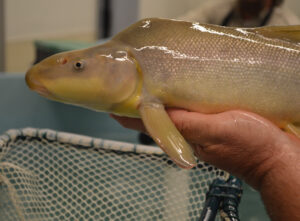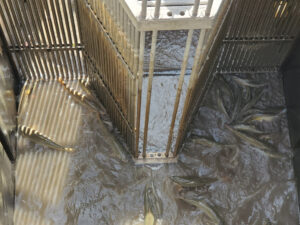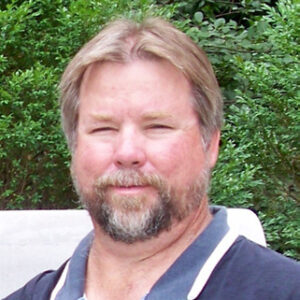For more than 30 years, the Upper Colorado River Endangered Fish Recovery Program has brought water users, power interests, conservation groups, and state and federal agencies together to support the recovery of endangered fish species. In this interview, Hydro Leader talks with three of the program’s fish experts about the program’s activities, which range from installing fish ladders and monitoring instream flow to reducing habitat for nonnative predators.
Hydro Leader: Please tell us about your backgrounds and how you came to be in your current positions.
Julie Stahli: I am the director of the Upper Colorado River Endangered Fish Recovery Program. I previously served as the recovery program’s deputy director for a couple of years and as the database manager prior to that. At one time or another, I’ve worked for partners in our program, including the States of Colorado and Utah, nonprofits, and water organizations doing either fisheries or policy work.
Dale Ryden: I am the project leader at the Grand Junction Fish and Wildlife Conservation Office. Our field station performs management and recovery actions on the four endangered fish species in the Colorado, Gunnison, and San Juan Rivers and in Lake Powell. I’ve been with this office for 32 years. I started off as a biological science technician, and I’ve worked my way up to the project leader position.
Travis Francis: I am the deputy project leader for the Grand Junction Fish and Wildlife Conservation Office. I’ve been with this office for 20 years, starting as a biological science technician and then working as a fish biologist. I moved into the deputy project leader position a couple of years ago.

Hydro Leader: Please introduce our readers to the recovery program.
Julie Stahli: The recovery program started back in 1988, when such programs were a novel concept. The partnership was formed after many years of debate between water users— people who were actively removing water from the Colorado and Green River systems—and those who were protecting endangered species in the river. It was a no-win situation that led to the new idea that everyone’s objectives didn’t have to be mutually exclusive. The program’s partners developed the program and have continued to work together over the past 30 years. They currently include the States of Colorado, Utah, and Wyoming; federal agencies, including the U.S. Fish and Wildlife Service (USFWS), the Bureau of Reclamation, the National Park Service, and the Western Area Power Administration; water users, represented by several water organizations in the states where we are active; power users, represented by the Colorado River Energy Distributors Association; and environmental interests, represented by the Nature Conservancy and Western Resource Advocates.
Hydro Leader: What are the main aquatic species you are seeking to protect?
Julie Stahli: The four species that we manage are the Colorado pikeminnow, the predator of the system and the largest minnow in North America; the razorback sucker, which is our only sucker species; the bonytail; and the humpback chub.
Hydro Leader: Are your main concerns addressing how flow levels and dams affect fish?
Julie Stahli: Flow levels and dam operations are definitely a piece of the puzzle, but we are looking at the system as a whole, including habitat and instream flow levels. We also manage nonnative fish, which have become our largest problem in the basin. Nonnative predators are widespread in the system and are negatively affecting native fish species. We carry out informational and educational efforts throughout the basin. We also propagate and stock fish to try to reestablish their populations and then monitor them. I think we’ve been creative in how we manage the dams in our system so that they are not in themselves an impediment to endangered species recovery. For low-head dams, we have worked to construct fish ladders to allow passage. For large dams, it’s all about how the water is managed when releases from those facilities occur. For example, by releasing water from a dam right after nonnative bass have spawned and larval bass are in the river, thus increasing flows and lowering temperatures, we can essentially eliminate an entire year’s class of bass, which would otherwise eat our native fish. We can also use reservoir operations to help us manage other program elements, for example by using spring peak flows to flood off-channel wetlands that serve as nursery habitat for young fish.
Hydro Leader: Please tell us how Redlands Dam fits into your fish recovery operations.
Dale Ryden: The Redlands Water and Power Company’s diversion dam is located in Grand Junction, about 3 miles up the Gunnison River from its confluence with the Colorado River. It’s a low-head dam that was completed in 1918. It spans the entire width of the river and is about the length of a football field. Although at 8½ feet it doesn’t sound very high, when you’re a fish, it’s certainly high enough to prevent upstream movement. The flows in the Gunnison can vary greatly, and lately, the high flows haven’t been very high, but at times, they can approach 20,000 cubic feet per second (cfs). The water passing over the dam forms an artificial plunge pool habitat immediately below the dam that can sustain nonnative predators, such as northern pike—species that can’t exist elsewhere in the lower Gunnison River during warm water months.
In the early 1990s, our office did some studies in the Gunnison River, knowing that it had historically had populations of endangered fish, particularly Colorado pikeminnow and razorback sucker. We found very few Colorado pikeminnow and no razorback sucker. After endangered fish emerge from the egg stage, their larvae drift downstream, sometimes several hundred miles. These young fish can drift downstream over low-head dams. As they grow, mature, and move back upstream, they can’t get back up over these low-head dams by themselves. Also, our adult endangered fish are highly migratory and can move downstream over these dams during their migrations. In the 1990s, the recovery program wanted to install a fish ladder on the Redlands Water and Power Dam, but staff didn’t know how to engineer it because nothing like this had ever been done for native or endangered fish in western Colorado. They studied salmon ladders in the Pacific Northwest and used them as a model. When they put this fish ladder in, they had no idea whether it was going to work. The first year, one endangered Colorado pikeminnow went through, which was considered a big success. We normally run this fish ladder from mid-April through mid-October, the period during which our native and endangered fish are active in the river system and migrating to spawn. Now, in a normal year, about 13,000–17,000 native fish use this ladder. It’s a selective fish ladder, meaning that there’s a trap on the upstream end where we can handle and sort fish. The native and endangered fish are allowed to go upstream, while the nonnative fish are either put back downstream or removed, depending on the level of threat they represent to endangered fish species.
Directly across the river from the Redlands fish ladder is the unscreened intake to the Redlands Water and Power Canal. A couple hundred yards down that canal is a fish screen that funnels fish back to the river through an underground fish return tube. We have a good partnership with Redlands Water and Power. It assists us with fish ladder maintenance issues. We also share flows that are delivered through the record of decision (ROD) for the Aspinall Unit dams. The ROD allows us to take 75 cfs to operate our fish ladder. When flows in the Gunnison River are low, that 75 cfs can be the only water in the Gunnison River for about a quarter of a mile, until the Redlands Water and Power Canal fish return tube returns its water to the river, so it is pivotal for the fish species. The ROD flows allow us to successfully provide passage for endangered fish in the lower Gunnison River, even during very low water years.

Hydro Leader: Was the fish ladder built on your organization’s budget, or did Redlands Water and Power contribute money to it?
Dale Ryden: It was built using recovery program funding, which is contributed by our partners. That money is divided between two types of expenditures: base funding and capital projects funding. Capital projects funding is used to construct things like fish ladders and hatcheries. Redlands Water and Power, like a lot of the other low-head dam operators in the Grand Valley, has a recovery program scope of work that helps it perform maintenance and repairs on its dam and canal. We bill the same account to maintain and repair the fish ladders and to repair and replace equipment as necessary.
Hydro Leader: Have you thought about putting an automated sorting system in the fish ladder?
Dale Ryden: The funny thing with fish ladders is you never really know what you’re going to get. You might have 3 fish in the ladder one day and 2,500 fish the next. Also, during storm events, or daily during high-flow periods, a lot of what we do is just cleaning sticks and mud out of the fish ladder and raising and lowering gates to help clean out the fish trap. You have no idea what you need to do to keep the facility operating correctly unless you’re out there on a daily basis. Another problem is hybridization among fish species. We get a lot of hybrid sucker species that need to be handled individually to determine what species they are. It would be extremely difficult to automate these activities, which really require on-the-ground decisionmaking. There are other problems we deal with at this facility. We have a large homeless presence in the area, and people cut fences and even attempt to fish in the fish ladder when we’re not there. Also, a lot of weird things, such as mattresses and lawn chairs, get thrown into the river upstream of the fish ladder and must be cleaned off the upstream trash racks.
Travis Francis: Many of the fish ladders in the Pacific Northwest that have automatic sorters deal with a few species that are already upstream of the dam or species that the operators want to get upstream of the dam, so they want to pass all those fish. In our situation, though, we have over 70 nonnative fish species, many of which aren’t found above Redlands Diversion Dam, so it’s important that we’re out there hand-sorting those fish. It would be difficult to have an automated program do that, because a lot of the species are similar in size and shape. In the 27 years that we’ve been operating the fish ladder, 211,233 fish have used it—171,000 native fish and just over 40,000 nonnative fish. We need to prevent the 19 percent that are nonnative from moving upstream.
Hydro Leader: What other fish management activities do you conduct as part of the recovery program?
Dale Ryden: We have another fish ladder at the Grand Valley Diversion Dam on the Colorado River just upstream of Grand Junction. Its design was based on the Redlands fish ladder and was completed in 2004. Although we corrected many of the mistakes we’d made when we built the Redlands fish ladder, we made a few new mistakes on that fish ladder because it was in a different section of the river and operated completely differently. There’s always a learning curve when you build a complicated structure like that. However, it is very successful in passing fish upstream. Downstream of that dam are two nonselective fish passage facilities that we help the water users run and maintain. We have a remote passive integrated transponder tag antenna at one of them, which provides a ton of data on which fish species are using it and which direction they are moving in. We do a lot of other fieldwork, including endangered fish population estimate studies and nonnative fish removal projects. We also have a fish hatchery in town, and every year, we stock endangered razorback sucker and bonytail in the river to boost populations. We also do fish community monitoring studies to understand how well endangered fish are surviving after stocking.
Travis Francis: We have wetlands that we’ve tried to maintain water connection to in order to promote rearing areas for native fish species. There are several gravel pit ponds throughout our area that are problematic. We want them dammed off because of nonnative fish production. We’re installing water control devices to let water into other ponds and wetlands when there are larval fish in them; then, we drain the ponds and return the larger juveniles to the main system.
Dale Ryden: In past years, one of the projects we’ve worked on is to perform fish salvage operations in irrigation canals. Once the canals are drained, we rescue native and endangered fish species and repatriate them to the river so they don’t die as the canals dry and freeze. During our biggest salvage year, we rescued something like 57,000 native fish from canals, including many endangered fish. Travis also mentioned working with Ecological Services, a branch of the USFWS. Our office frequently lends professional expertise to help it assess the effects of bridge abutment rebuilding projects or road projects that cross waterways on native and endangered fish species. The idea is to minimize the amount of habitat the use of materials such as riprap boulders might create for nonnative fish.

Hydro Leader: What are the best ways to balance hydropower generation and fish safety?
Dale Ryden: Our main concern is to try to prevent fish from being entrained in canals. To that end, our partners have been very good about installing, operating, and maintaining fish screens on their canal intakes. In cooperation with the recovery program, they’ve installed fish screens and made additions and upgrades to their canals to help them run their facilities more efficiently. It takes extra work to run the fish screens and prevent fish from getting into their canals and power plants, but it’s been a good partnership.
Julie Stahli: What we’ve learned in working with our partners is that we can manage hydropower generation and endangered species conservation at the same time.
Travis Francis: We are fortunate to be working in a program in which partners with different interests can sit down at a table and work together to benefit native species while accommodating the community’s hydropower and irrigation needs. Our work to help these endangered species recover also benefits the other native plants and animals that depend on the river.
Julie Stahli is the director of the Upper Colorado River Endangered Fish Recovery Program. She can be contacted at julie_stahli@fws.gov.

Travis Francis is the deputy project leader at the U.S. Fish and Wildlife Service’s Grand Junction Fish and Wildlife Conservation Office. He can be contacted at travis_francis@fws.gov.

Dale Ryden is the project leader at the U.S. Fish and Wildlife Service’s Grand Junction Fish and Wildlife Conservation Office. He can be contacted at dale_ryden@fws.gov.


